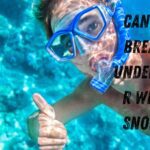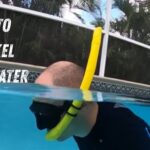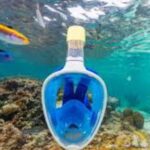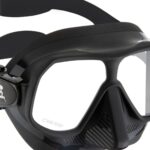What Do You Need For Snorkeling – Expert’s Guide to Not Drowning in Regret
What do you need for snorkeling? Well, besides a sense of adventure and a mild willingness to look like an underwater bug, you’ll need more than just a tube and hope.
Did you know? Snorkeling dates back thousands of years. Ancient Greeks used hollow reeds to peer below the water’s surface, long before silicone masks and anti-fog sprays made it cool.
Fast forward to now, snorkeling is one of the easiest, most affordable ways to explore the marine world, but only if you’re prepared. The gear might seem simple, but choosing the right snorkeling equipment can mean the difference between floating peacefully with sea turtles… or gagging on saltwater while fighting with your fogged-up mask.
What Do You Need for Snorkeling?
Let’s get this out of the way. The core essentials for snorkeling are:
1. Snorkel Mask: Your Underwater Window
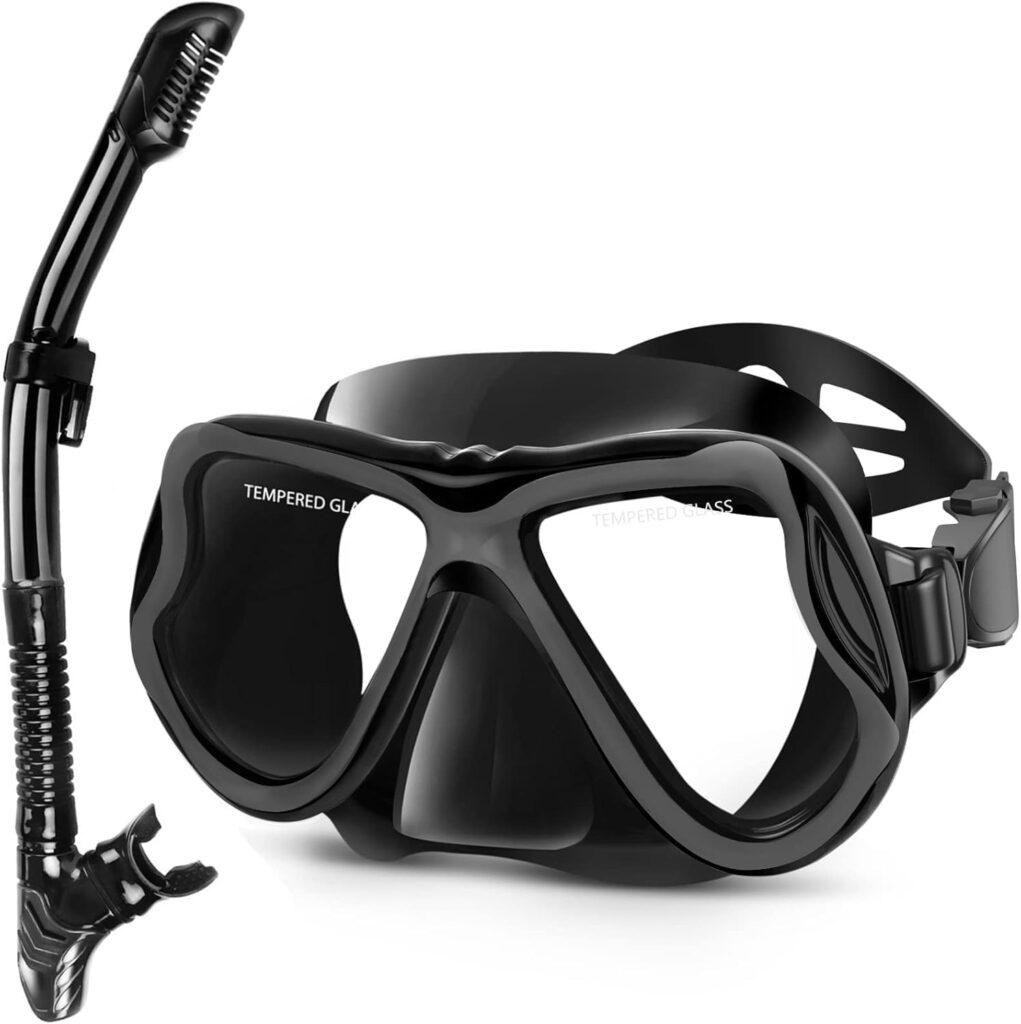
Purpose: A snorkel mask allows you to see clearly underwater by creating an air space in front of your eyes and nose.
Key Features to Consider:
- Tempered Glass Lens: Ensures durability and resistance to pressure.
- Silicone Skirt: Provides a comfortable and watertight seal against your face.
- Adjustable Strap: Allows for a secure fit, preventing water from seeping in.
Fit Test:
- Place the mask on your face without using the strap.
- Inhale gently through your nose.
- If the mask stays in place without air leaks, it fits well.
Tips for Use
- Fogging: New masks often have a silicone residue that causes fogging. Clean the inside of the lens with non-abrasive toothpaste before first use.
- Leaking: Ensure the mask fits properly and the skirt lies flat against your skin. Facial hair can interfere with the seal.
READ ALSO: How Much Weight Should I Use For Snorkeling
2. Snorkel: Breathing Made Easy
Purpose: A snorkel allows you to breathe while floating face-down on the water’s surface.
Types of Snorkels:
1. Classic (J-Shaped) Snorkel:
- Simple design with no valves.
- Requires manual clearing of water.
- Preferred by experienced snorkelers for its reliability.
2. Semi-Dry Snorkel:
- Features a splash guard to reduce water entry.
- Includes a purge valve for easy clearing.
- Ideal for casual snorkelers.
3. Dry Snorkel
- Equipped with a valve that seals the tube when submerged.
- Prevents water from entering, reducing the need for clearing.
- Great for beginners and those who prefer a hassle-free experience.
Tips for Use
- Water Ingress: Dry snorkels help prevent water from entering the tube, enhancing comfort.
- Jaw Fatigue: Choose a snorkel with a comfortable mouthpiece to reduce strain.
| Type | Best For | Features |
| Classic Snorkel | Experienced snorkelers | Simple J-shaped, no valves |
| Semi-Dry Snorkel | Casual snorkelers | Splash guard, basic purge valve |
| Dry-Top Snorkel | Beginners and kids | Valve closes when submerged |
| Full-Face Mask with Integrated Snorkel | Nervous beginners | Easier breathing, limited depth |
Note: Full-face masks are comfortable but controversial. Not suitable for deep diving and not recommended for people with asthma or medical conditions.
Check This : Do You Need to Know Swimming for Snorkeling
3. Fins: Glide Through the Water
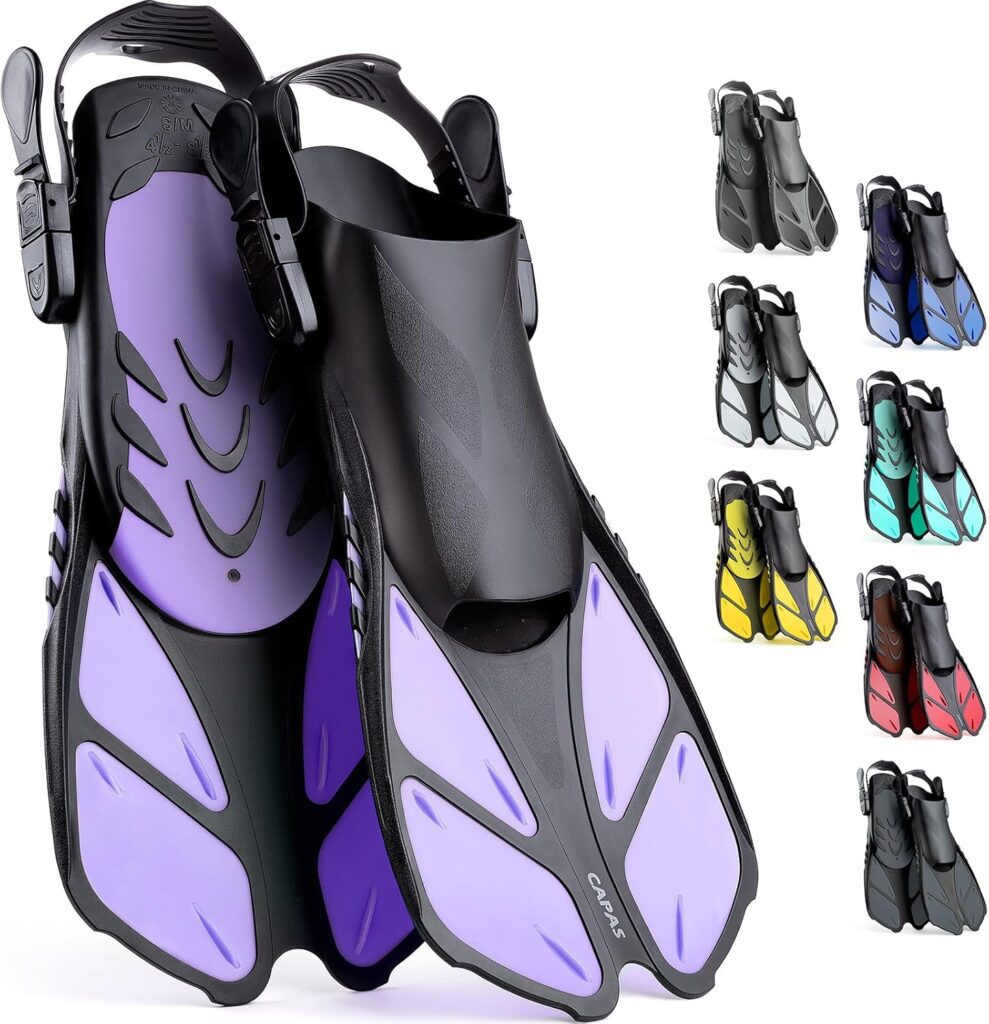
Purpose: Fins increase propulsion, allowing you to move efficiently with less effort.
Types of Fins
1. Full-Foot Fins:
- Enclosed heel design.
- Best for warm waters.
- Worn barefoot.
2. Open-Heel Fins:
- Adjustable straps for a customizable fit.
- with neoprene booties.
- Suitable Worn for various water temperatures.
Fit Tips
- Fins should fit snugly without causing discomfort.
- Avoid fins that are too tight or too loose, as they can cause blisters or fall off.
Tips for Use
- Blisters: Wearing booties with open-heel fins can prevent chafing.
- Leg Fatigue: Choose fins with appropriate stiffness for your strength and experience level.
4. Protective Clothing: Guard Against the Elements
Purpose: Protective clothing shields you from sunburn, jellyfish stings, and abrasions.
Options
- Rash Guards: Lightweight shirts with UV protection.
- Wetsuits: Provide thermal insulation and protection in cooler waters.
- Swim Leggings: Cover your legs for additional sun and sting protection.
Tips for Use
- Sunburn: Extended exposure can lead to severe sunburns. Always wear protective clothing and apply reef-safe sunscreen.
- Cold Water: Wetsuits help maintain body temperature, allowing for longer snorkeling sessions.
5. Snorkel Vest: Float with Confidence
Purpose: A snorkel vest provides buoyancy, helping you stay afloat effortlessly.
Benefits
- Ideal for beginners or those not confident in swimming.
- Allows for adjustable buoyancy by inflating or deflating the vest.
Tips for Use
- Fatigue: A snorkel vest reduces the energy required to stay afloat, preventing exhaustion.
- Safety: Enhances visibility and safety, especially in open waters.
6. Reef-Safe Sunscreen: Protect Your Skin and the Ocean
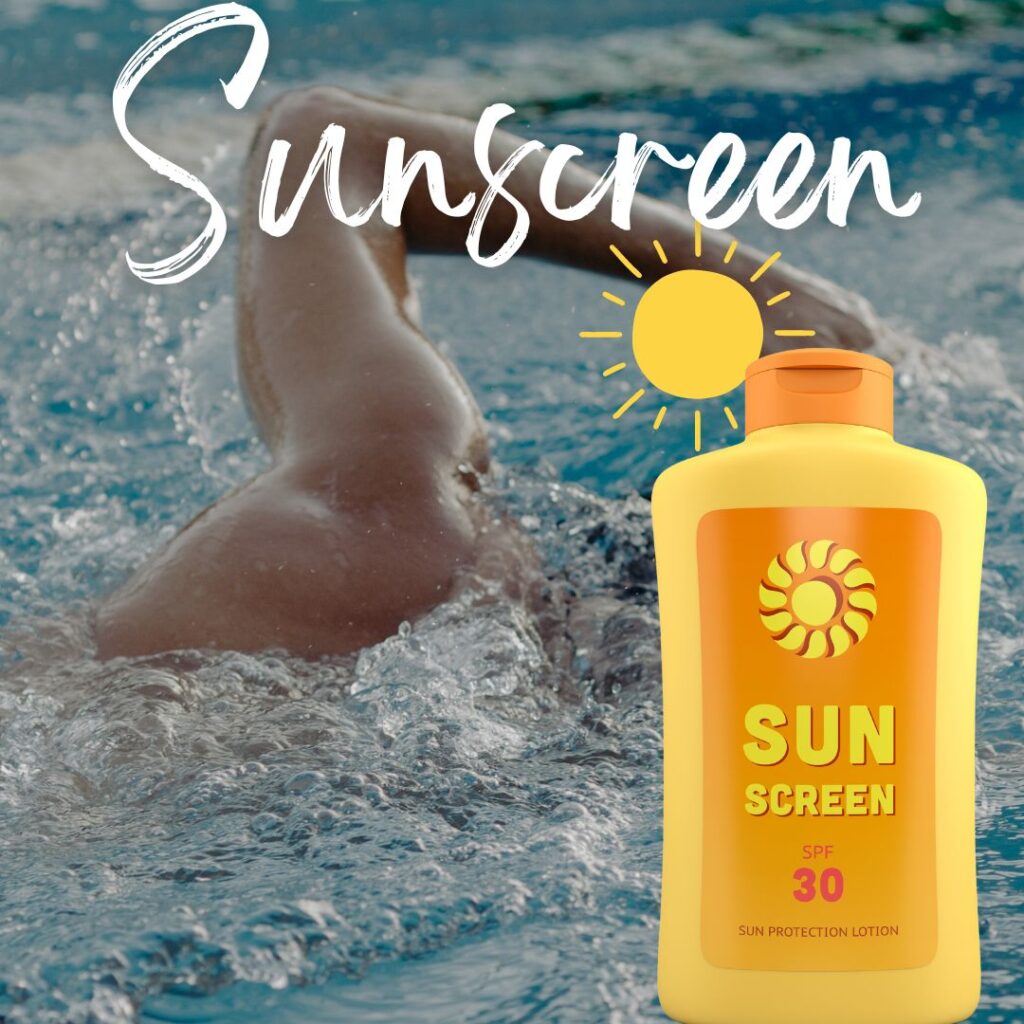
Purpose: Sunscreen protects your skin from harmful UV rays.
Why Reef-Safe?
- Traditional sunscreens contain chemicals like oxybenzone and octinoxate, which can harm coral reefs.
- Reef-safe sunscreens use mineral-based ingredients like zinc oxide or titanium dioxide.
Tips for Use
- Environmental Impact: Using reef-safe sunscreen helps preserve marine ecosystems.
- Skin Sensitivity: Mineral sunscreens are often gentler on sensitive skin.
7. Anti-Fog Solutions: Maintain Clear Vision
Purpose: Prevent your mask from fogging up, ensuring clear visibility underwater.
Options
- Commercial Anti-Fog Sprays: Specifically designed to prevent fogging.
- DIY Solutions: A diluted baby shampoo solution can be an effective alternative.
Application Tips
- Apply the solution to the inside of a dry mask.
- Rinse lightly with fresh water before wearing.
Tips for Use
- Fogging: Proper application of anti-fog solutions ensures uninterrupted underwater viewing.
8. Gear Bag: Organize and Transport Your Equipment
Purpose: A gear bag helps you carry and store your snorkeling equipment conveniently.
Features to Look For
- Mesh Design: Allows for ventilation and quick drying of wet gear.
- Compartments: Separate sections for different items to stay organized.
- Durability: Sturdy materials to withstand travel and exposure to elements.
Tips for Use
- Mildew: A mesh bag prevents moisture buildup, reducing the risk of mildew.
- Convenience: Having all your gear in one place simplifies transportation and storage.
Check out top snorkel sets from brands like Cressi, Seavenger, and US Divers. They often bundle quality gear at affordable prices — perfect if you’re new to this world and don’t want to buy each item separately.
How to Use Snorkel Gear Like a Pro (Or at Least Not Panic)
Using snorkel gear isn’t hard, but you need to practice a few simple steps before hopping into the water like a dolphin.
Before You Enter:
- Adjust the mask snugly – not too tight.
- Place the snorkel on your dominant side.
- Bite the mouthpiece gently and keep lips sealed around it.
In the Water:
- Float face down. Breathe slow and steady through your mouth.
- Don’t panic if water enters. Simply blow forcefully to purge.
- Use fins for movement – don’t waste energy waving your arms.
Practice in a pool or calm shallow beach first. You’ll feel less like a flailing fish.
Snorkeling With Kids: What You Actually Need
Snorkeling with children? Prepare for questions, splashing, and “Mom, there’s a fish RIGHT THERE!”
Here’s what helps:
- Full-face masks for kids (check safety guidelines)
- Snorkel vests or float belts (they’ll get tired quickly)
- Bright rash guards (easier to spot your kids)
- Short sessions first – build confidence slowly.
Make sure they test everything in a pool or shallow water before heading out. Knowing how to use snorkel gear before the trip avoids meltdowns later.
What You Need Based on Where You’re Snorkeling
Different environments = different needs. The question what do you need for snorkeling isn’t one-size-fits-all.
Tropical Destinations (Hawaii, Maldives, Mexico)
- Reef-safe sunscreen
- Lightweight gear
- Rash guard or lycra suit
Colder Waters (California, Iceland)
Snorkeling from a Boat
- Snorkel vest
- Compact fins
- Dry bag for valuables
The best snorkeling equipment adapts to your surroundings. Plan ahead.
Should You Rent or Buy Snorkeling Equipment?
Renting Pros
- Saves suitcase space
- Cheap for a one-time adventure
Buying Pros
- Hygiene (your mouth, your rules)
- Custom fit
- Long-term savings
If you’re snorkeling more than twice a year, investing in top snorkel sets makes more sense. You’ll avoid the one-size-doesn’t-fit-anyone rentals.
How to Clean and Care for Your Gear
Don’t just toss your gear in a pile like soggy spaghetti.
After each use:
- Rinse with fresh water
- Soak mask and snorkel in warm water + mild soap
- Air dry (not in direct sun)
Storage tip: Store your mask flat to avoid warping. Hang snorkels and fins. It’ll last years if you treat it right.
Mistakes to Avoid on Your First Snorkeling Trip
Let’s make sure you don’t end up on someone’s snorkeling fail video:
- Mask too loose = water leaks
- Foggy mask = missed coral beauty
- Going out alone = bad idea
- Touching coral = BIG no-no (and possibly illegal)
- Not knowing how to use snorkel gear = stress & salty lungs
Travel Tips: Packing Snorkel Gear Like a Pro
- Use a mesh gear bag (for airflow and TSA smiles)
- Pack fins in your checked bag, mask/snorkel in carry-on
- Travel fins (shorter) save space
- Don’t forget reef-safe sunscreen (many destinations ban regular sunscreen)
If you want to travel light, grab one of the top snorkel sets designed specifically for travelers. They’re lightweight, packable, and often include a carry bag.
FAQs: What Do You Need for Snorkeling?
Q: Can I snorkel if I can’t swim?
A: Yes, with a snorkel vest and under supervision. Stay in calm water.
Q: Is a full-face mask better?
A: It’s more comfortable for beginners, but not good for diving or high-intensity snorkeling.
Q: What’s the best way to prevent foggy masks?
A: Use anti-fog spray or baby shampoo + rinse. Avoid touching the lens inside.
Q: What brand has the best snorkeling equipment?
A: Cressi, Mares, US Divers, and Seavenger are reliable choices.
Q: How do I know if my snorkel gear fits properly?
A: Your mask should suction to your face without a strap. Fins should be snug, not tight. Try before you travel!
The Bottom Line on What Do You Need for Snorkeling?
What do you need for snorkeling? You need gear that fits, floats that help, and a mindset ready for exploration.
Whether you’re peering at parrotfish off the coast of Maui or floating over coral in Belize, the right snorkeling equipment makes all the difference. Invest in comfort. Know your environment. Practice ahead of time. And most of all — enjoy the ocean, don’t fight it.
Because nothing ruins a tropical vacation faster than saltwater in your nose and a foggy mask.
